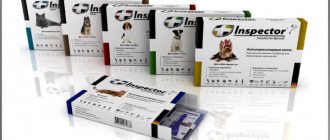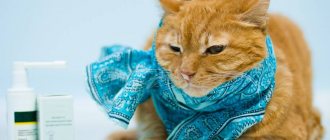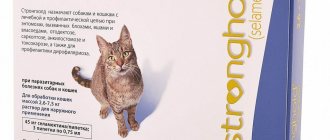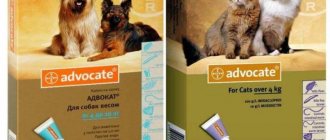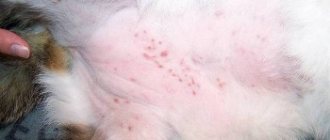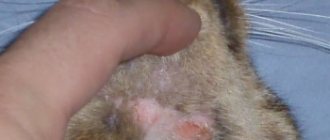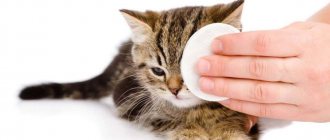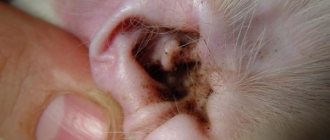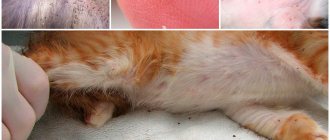Main symptoms of poisoning
Flea drops are highly toxic drugs. This is why they are so effective in controlling harmful insects. By licking a certain amount of flea drops, a cat can get away with a slight illness or get seriously poisoned. It all depends on the animal’s immunity, its age, the general condition of the body and how much of the product has entered the stomach. The following signs usually indicate intoxication:
- The cat refuses food, does not even eat what it used to love.
- The animal constantly drinks water.
- There is increased salivation.
- The pet's pupils are greatly dilated.
- The cat is poorly oriented in space (it takes a long time to decide to jump, lick food from the owner’s palm, the animal skids and staggers). He doesn't retract his claws all the way (meaning his paws go numb).
- Diarrhea appears.
© shutterstock
You should be able to distinguish between situations when a cat is poisoned by flea drops and when he is allergic to them. It can manifest as tearing, itchy skin, and bald patches in the area where the product was applied. Licking drops is one thing, but having an individual intolerance to them is quite another.
How to help your pet
Having noticed alarming symptoms, you need to try to alleviate the condition of a cat poisoned by flea drops as much as possible. Ideally, take the animal to the veterinarian and place it in the hands of a professional. However, this is not always possible, and it’s a shame to look at a cat. What to do in this case?
You can give the animal rice water. It is prepared by pouring one and a half tablespoons of cereal with half a liter of water and boiling over low heat for about forty minutes. The cooled and strained liquid is offered to the cat. Since he is constantly thirsty, most likely he will not refuse the medicine. Otherwise, the broth is poured inside the cat using a syringe.
Among medications for poisoning with flea drops, Smecta is used. Half a sachet of this drug is diluted with two tablespoons of water and poured into the mouth or offered to the animal as a drink. The danger to a cat can be significantly reduced by allowing the animal to lick half a tablet of regular activated carbon, crushed and dissolved in water.
It will draw out all toxins from the body. No-Shpa will help relieve the condition caused by the drops. The dose of this drug for an adult cat is also 0.5 tablets. But the intestinal microflora is perfectly restored by the prebiotic for animals “Vetelakt”. The specifics of its use are described in the attached instructions.
© shutterstock
A cat that has been poisoned by flea drops should drink more. You can add a little potassium permanganate to the water if the incident occurred recently. Fatty, salty, sweet foods are contraindicated for the animal during this period. Most likely, the cat himself will refuse such food, because his appetite is practically zero.
What to do in case of poisoning
Treatment of poisoning with flea drops is carried out by a veterinarian. When the first signs of disease appear, you should take your pet to a veterinary hospital. If for some reason you cannot do this right away, for example, if symptoms develop at night and there is no 24-hour hospital nearby, begin to provide first aid yourself. Below we looked at its main components:
- Give your pet the sorbent to drink. Regular activated carbon will do. Calculating the dosage is very simple: for 10 kg of animal weight you need to take 1 tablet of coal. So for a cat weighing 5 kg you will need half a tablet. The medicine must be dissolved in 5-10 ml of plain water and administered into the animal’s mouth through a syringe (without a needle).
- Give your pet plain water. This is best done with a syringe. Pour 5-10 ml of liquid into the animal's mouth every 10 minutes. Drinking will help reduce the severity of intoxication syndrome.
There is nothing more you can do to help the animal. There is no need for an enema or gastric lavage, since most of the drug is absorbed into the body through the skin. Further treatment will be carried out in a veterinary clinic.
Prognosis and prevention
All owners, without exception, are interested in how dangerous poisoning with flea drops is. Veterinarians reassure: the cat will not die if it has not swallowed a whole bottle of the product. Most likely, she was “lucky” to lick off quite a bit of the drug.
However, in this state the animal cannot be left without attention. Drop poisoning is a serious stress for the body that can provoke other dysfunctions. Old or sick individuals, as well as kittens, suffer the most from intoxication.
To avoid poisoning, you should drip the product exclusively onto the withers. This is the place where it is most difficult for an animal's tongue to reach. However, sometimes the cat licks drops from this place too - after all, the animal’s body is very flexible and dexterous. Therefore, it is not enough to simply apply the product to the withers in the required amount. Additional measures need to be taken. Let's say, put a special collar on the cat's neck, which will prevent the fluffy from licking himself.
It is not uncommon for several animals to live in one house. By treating one pet with fleas, it is easy to jeopardize the health of another. Animals tend to lick each other. When fighting fleas, you should keep your tailed pets separately.
Well, one last thing: you need to choose high-quality drops. And buy them in specialized pharmacies or stores. Poisoning with a low-grade flea remedy of dubious origin can have unpredictable consequences.
Poisoning cats and dogs with flea products
Flea drop poisoning is a fairly common disease in dogs and cats . Owners treating their pets against potentially dangerous parasites can cause great harm to their health and lead to severe intoxication of the body. In this article, we looked at the causes and symptoms of flea poisoning in cats and dogs, first aid methods and components of treatment for this pathological condition.
General rules of use
Typically, drops against fleas and ticks are applied to the animal's skin at the withers. To do this, you need to carefully move the fur apart and apply the dose of the drug indicated in the instructions. For better effect, the product can be rubbed into the skin. After this procedure, the kitten cannot be combed or washed for 2-3 days.
Sometimes manufacturers recommend applying droplets not only to the withers, but also along the spine. This is done in exactly the same way as in the first case. Each drug has its own dosage, so be sure to read the instructions before applying the product. It also describes in detail the number of flea drops.
Sometimes your veterinarian may recommend using a spray instead of drops. In this case, the drug must be applied differently. For example, Fipronil spray must be sprayed onto the entire skin of the animal.
Typically, flea and tick drops are applied to the animal's skin at the withers.
It is important to note that if a cat or kitten lives outside, you need to make sure that the animals do not get wet after the procedure. If after applying the drug the animal gets caught in the rain, it makes sense to repeat the disinfection. Although most drops are not very toxic, care must be taken not to get the product on the animal's nose, mouth or eyes. Otherwise, the mucous membrane should be rinsed with plenty of water.
You also need to know that not all drops can be used for a kitten. Sometimes the manufacturer prescribes a different dosage for small pets. Otherwise, you need to buy special flea drops for kittens. Therefore, before purchasing such drugs, you must inform the seller of the age of the animal.
How to protect an animal from poisoning
No one will deny that it is easier to prevent a problem than to solve it. Therefore, you should take care in advance so that your pet does not harm itself.
Manufacturers recommend applying flea treatment to the withers area. The drops act the same, regardless of where they are applied, however, here they are most difficult to lick off. A pet simply will not be able to turn its head so as to reach the withers.
However, this does not mean that he will not have the opportunity to lick off the insecticide. A cat can become poisoned by licking the fur of another pet.
If there are several pets in the house, it is better to keep the animals separately, at least for the first two hours after treatment, until the product is absorbed.
If you encounter a nimble animal or the drops are applied unevenly, the pet will be able to reach distant areas on its fur and begin to lick off the insecticide.
To prevent this from happening, during treatment you can attach a collar to the fluffy’s neck, because of which the cat will no longer be able to turn his head and get to the poison.
If you find an error, please select a piece of text and press Ctrl+Enter. We will definitely fix it, and you will get + to karma
Veterinarians recommend that if an adult cat or kitten is poisoned by flea drops, immediately take him to the clinic, as death is possible. Most often, intoxication occurs due to the negligence of the owner, the wrong place of application, or an overdose of the medication. To stop the symptoms of poisoning, the cat needs to undergo treatment with steroids and drips with saline solutions. At home, you can only reduce the negative effects of chemicals.
Allergy to toxins
If you apply flea drops correctly to the withers, the cat should not lick them off. The situation is much more complicated if the kitten is also treated with a toxic agent. Then the cat can become poisoned by licking its cubs. If there is only one kitten, then there is no need to worry too much, but if there are several kittens, you need to think through safety measures in advance.
It is better to protect the animals from each other for a couple of days. If the drug is licked by a small pet, the poison can act on it several times more powerfully. In addition, it is important to note that small kittens can grab each other by the neck while playing and thus ingest toxins.
Allergic reactions to flea drops for cats are extremely rare. But if your pet shows obvious allergy symptoms after applying the drug, and they do not go away within 1-2 days, you should urgently seek help from a veterinarian.
If you correctly apply drops to the withers against fleas, the cat should not lick them off
Dangerous symptoms include:
- itching at the site of application of the drug;
- hair loss;
- dermatitis.
A person also needs to be extremely careful when applying the drug. It is better to use gloves, and after the procedure, wash your hands thoroughly with soap. It is also recommended not to handle the animal for several days. Toxins can remain on the pet's skin, so upon contact with it, the poison can cause allergies in the owner.
But drops for cats have little toxicity for the animals themselves; such drugs act much more aggressively on fleas. Some parasites die immediately after applying the drug. This often happens when an insect gets into the area of the skin where the drops were applied. Other parasites try to escape from their host as soon as they smell an unbearable smell.
>Flea drops for cats can be dangerous (video)
Careful use
Treating your pet with anti-flea drops
Manufacturers use insecticides of a certain dosage to make their products. A minimal amount is enough to eliminate fleas from a cat, but the dose remains safe for animals.
The fact that it is recommended to drip in places inaccessible for licking is alarming: the area of the withers between the shoulder blades, along the spine. However, these recommendations relate more to the effectiveness of the product than to the safety of cats.
All modern drops for cats work the same way. Within 2 hours they are absorbed by the skin, localized in the hair follicles and sebaceous ducts. If the drops are licked off and do not have time to be absorbed, protection against fleas cannot be called complete.
Effective drugs
There are a number of drugs, the results of clinical studies of which indicate their effectiveness and relative safety. The most popular flea treatments include:
- Beaphar.
- Leopard.
- The barrier is super.
- Hartz.
- Fipronil.
Beafar is a disinfectant that can be applied to both cats and small kittens. In addition, this remedy is also indicated for pets who are weakened after illness. Biafar is considered the safest drops, since their components are absolutely harmless to animals. Therefore, you should not worry if your cat licks your kitten after applying the product. The effect of this drug can last for 2 weeks.
The classic drug of the Bars brand - drops and the new drug Bars Forte contain a toxic substance of the phenylpyrazoles group - fipronil
Domestic drops Bars begin to act immediately after applying them to the pet’s skin. But they cannot be used to disinfect pregnant or lactating cats. It is also not recommended to use the drug for cats that are under 10 weeks old. For such animals, the manufacturer produces a milder product.
Barrier-super can be given to kittens that have reached 12 weeks of age. The effect of the drug lasts for 2 months, so it guarantees high efficiency. Thanks to long-term exposure, toxins destroy cat fleas at all stages of development. A convenient dispenser allows you to carefully apply the drug to the withers. There is no need to place drops along the spine.
Hartz flea and tick drops are not cheap, but one package contains 3 pipettes, each of which has an effect for 1 month. It is important to note that this drug is not afraid of moisture. Toxins remain on the animal's skin, even if the pet is exposed to rain. The manufacturer produces the drug in different dosages, which depend on the age of the cat. However, this remedy should not be used on sick or debilitated cats, or on kittens under 12 weeks of age. This flea preparation does not need to be washed off.
Fipronil is a flea spray. It should be applied to the skin only in fresh air or in a well-ventilated area. The drug must be sprayed at a distance of 10 cm from the skin, gently lifting the hair. Fipronil should moisten the skin; for a better effect, you can rub it a little. Processing must be carried out only with gloves. The manufacturer also recommends moistening a napkin with the preparation and treating the animal’s ears, skin folds and paws with it. During the first 10 minutes after disinfection, contact with the animal is prohibited. It is also not recommended to bathe him for the next 3 days.
To choose the most optimal remedy, it is advisable to consult a veterinarian. If for some reason this is not possible, when purchasing the drug, it is imperative to inform the seller of the age and weight of the animal, and the degree of parasite damage. This will help you get rid of fleas quickly and effectively.
Useful materials:
- How to apply chloramphenicol drops What are chloramphenicol eye drops prescribed for? Share Eye drops Levomycetin is an ophthalmic drug intended...
- Cutaneous horn General description of the disease Cutaneous horn on the forehead or face (ICD 10 code - L57.0) -...
- Itching and odorless discharge Main causesBefore considering the factors that provoke the appearance of discharge that has a sour odor, it is necessary to immediately note...
- Normal temperature in animals Normal temperature in different types of animals Veterinary services Day hospital for animals Veterinary certificates Vaccination…
